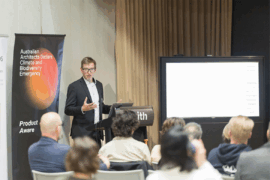Step into post-war Italy at Joyce Wang’s latest restaurant and bar project, where a multitude of beautiful details come together to tell a story.

The new Italian eatery in town tells a story: one of 1950s Italy. It’s a story that comes through when you look at the venue – formerly another Italian restaurant, Lupa, which was also a Dining Concepts endeavour – as a whole, and also when you take the time to notice the details.
There’s the subtle acid etching on the terrazzo floor at the centre of Spiga, which was inspired by a pattern found on the stones of a piazza in Rome. Then there are the leather straps hanging from the ceiling in an area to the side of this, a nod to the equestrian history of Campo de’ Fiori, also in Rome. Let’s not forget all the circus paraphernalia on display in glass cases at the bar, or the bar itself, which is clad in leather insoles – some of which come from vintage Italian shoes, and the rest of which were procured locally.
These are the hallmarks of Joyce Wang’s style: she and her team pay attention to the little things, and how they come together to form a complete and multi-layered whole. “There are all these really subtle details I feel like no-one would really notice unless I pointed them out,” says Wang.
There’s a very cinematic quality to this space – one that partly stems from the loose influence 1950s Italian films had on the design (Fellini’s films, for example, were a reference point for the Italian settings of the era), and one that also comes from Wang’s desire to create a narrative you have to take the time to uncover. “It has to be unraveled, like a film. It adds layering to it, it makes somebody want to actively figure out the story,” she says.
In fact, each area of this restaurant has its own story. The bar and banquette seating area draw on “street performers in the different Italian piazzas and also the circus,” explains Wang. Meanwhile, at the back by the open kitchen, is a busy dining area, which takes its cues from the Milan metro.
Dominating one wall is an attention-grabbing light, which is “an abstraction of the Milan metro map,” says Wang. “The chairs also have this tubular aspect to them. The floor here is the Milan metro flooring. All the buckles, all the leather, they reference Milan’s well-dressed businessmen. I knew this area by the kitchen was going to be bustling, so it needed to feel more urban and ‘Hong Kong’.”
Certain elements pull all the varied spaces together: the lighting, which was the starting point for the design of each space; the terrazzo flooring and the use of marble on floors and tables; the leather elements in surprising places; and the palm motif, found on vintage brass palms, and on the palm-leaf fabrics in the private dining area, and on the terrace.
The terrace is home to Portico, the venue’s outdoor bar, which is a haven of cabanas and expansive lounge seating. Lupa’s central bar has been removed, making the space feel much bigger and more connected. At the same time, the cabanas and the overhead drapery give the terrace a cosiness that makes you feel far from Hong Kong’s CBD.
This is the beauty of Spiga, and indeed, of Wang’s design in general: it transports you to another time and another place, whether fictional or real – or a mix of both.
INDESIGN is on instagram
Follow @indesignlive
A searchable and comprehensive guide for specifying leading products and their suppliers
Keep up to date with the latest and greatest from our industry BFF's!
The new range features slabs with warm, earthy palettes that lend a sense of organic luxury to every space.

London-based design duo Raw Edges have joined forces with Established & Sons and Tongue & Groove to introduce Wall to Wall – a hand-stained, “living collection” that transforms parquet flooring into a canvas of colour, pattern, and possibility.

As a Luminary this year, Joyce Wang is the epitome of someone who leads by example and creates her own pathway of design.

Since founding her practice in 2011 Joyce Wang has carved out an international name for herself, establishing studios in Hong Kong and London. She’s a jet-setting mother-of-three, but she is not interested in world design domination, rather her focus is on upending the status quo.

Joyce Wang of Joyce Wang Studio joins our 2019 INDE.Awards Jury. Here we take a look at her latest collection – Flint – which is a testament to the firm comeback of terrazzo.

The future of hospitality is multi-sensory: touch, smell, sound and so on. How then are we personifying our clients in the design of their spaces, and how can we pull this off without being gimmicky? A new Hong Kong restaurant and bar by Joyce Wang Design Studio takes a different approach, encapsulating the chef’s character and culinary style in the space itself.
The internet never sleeps! Here's the stuff you might have missed

Where style and substance truly dwell, Gardam’s latest modular collection – available through Stylecraft – balances elegance and versatility.

In a landscape clouded by data and greenwash, Product Aware offers architects and designers a common language for sustainability. Embraced by suppliers – including Milliken – it is setting a new benchmark for trust and bringing clarity and accountability to material specification.